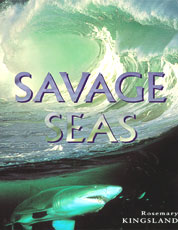|

Rosemary
Kingsland’s book "Savage Seas" is the companion volume
to the PBS television series of the same name. Part of a documentary
trilogy by Granada Television, the "Savage Seas" series
and its sister series, "Savage Skies" and "Savage
Earth," "have explored the relationship between mankind
and the immense natural forces which shape our life and our
planet."
According
to the author, the impact of this relationship cannot be overstated;
in the introduction she writes, "If the sea holds a compelling
fascination for us, it is because we are part of it. The first
glimmerings of life were born in the sea some 3,000 million years
ago…the salts that surged through the waters of the deep oceans
from pre-history to today still surge through our blood." Our
origins in water, she continues, are evidenced by the human body’s
composition of sodium, potassium and calcium in the same proportions
as found in seawater. Even our discharge of water in the form of
sweat and tears is comparable to the salt found in the earth’s
seas.

The
book is divided into six sections. Each section contains smaller
chapters that explain the relationship of the seas to the earth and
its cycles.
"The
Water Planet" describes the effects of the motions, twists and
pulls of the oceans’ currents, tides and waves. These powerful
forces have shaped the planet’s weather, geography and human
history. Trade, exploration and settlement have all been affected by
these natural phenomena. Mighty ships designed to sail the roughest
waters can disappear in a matter of minutes (such as the 1909 Dutch
ship SS Waratah).
"The
Weather Machine" explores what is arguably the most important
and powerful effect that the oceans have on the planet. So powerful
is this weather machine that it can give birth to hurricanes off the
coast of Africa that wreak havoc in North America; create killer
monsoon-driven waves in the Indian Ocean; and create typhoons and
cyclones that contain raging winds, driving rains and excessive
amounts of snow.
"The
Big Chill" discusses the presence of cold in the oceans,
contributed in part by the immense amounts of floating ice.
Kingsland writes, "Our world begins and ends in ice…in the
north it is a cap up to fifty meters thick in winter, in the south
it covers a continent the size of Europe." Sea ice has plagued
sailors and explorers since humans first began ocean travel.
Kingsland examines the sinking of the Titanic in terms of the role
that ice played in the disaster. She analyzes the cold-water shock
associated with this shipwreck as well as the 1994 Baltic Sea
sinking of the ferry Estonia (with 852 victims).
[to top of second column in
this review]
|
"Under
Pressure" looks at deep-sea diving and underwater exploration.
As air-breathers, humans have long been fascinated with the world
beneath the waves. Many different methods of underwater exploration
have been tested over the centuries. The author cites two
interesting examples from the annals of history: Alexander the Great’s
Aegean Sea diving barrel and Edmund Halley’s diving bell in 1690.

Perhaps
the most entertaining reading in the book is found in "Monsters
of the Deep." Here we discover the fabled man-eating monsters
that have plagued ships and boats. Sharks, crocodiles and sea
serpents (real and imagined) are some of the inhabitants of the deep
that strike terror in sea goers. One sobering chapter in this
section chronicles the sinking of the USS Indianapolis and the
subsequent shark attacks that the crew endured before their rescue.
Told through the firsthand accounts of crewmen Robert McGuiggan, Guy
Kay and Michael Kuryla, the story of the Indianapolis and the tragic
events that followed are testament to the awesome power of the ocean
and the dangerous creatures that it harbors.
A
brief concluding section, "Surviving the Savage Seas,"
instructs on how to prepare for the worst at sea and what to do when
calamity strikes (again told through firsthand accounts).
"Savage
Seas" is a wonderful introduction to the different seas and
oceans on our planet. The firsthand accounts of seagoing experiences
combine with the stunning photography to demonstrate the sea’s
majestic power, beauty and danger. Further reading on this subject
can be found in the bibliography. The book’s many illustrations
are conveniently included in the subject index. The writing is
lively and captures the reader’s attention from beginning to end.
"Savage Seas" is recommended to all readers young and old
who are interested in the planet’s greatest and most dangerous
natural force.
For
more information, visit the library at 725 Pekin St. or call (217)
732-8878.
[Richard Sumrall, Lincoln
Public Library District]

|

